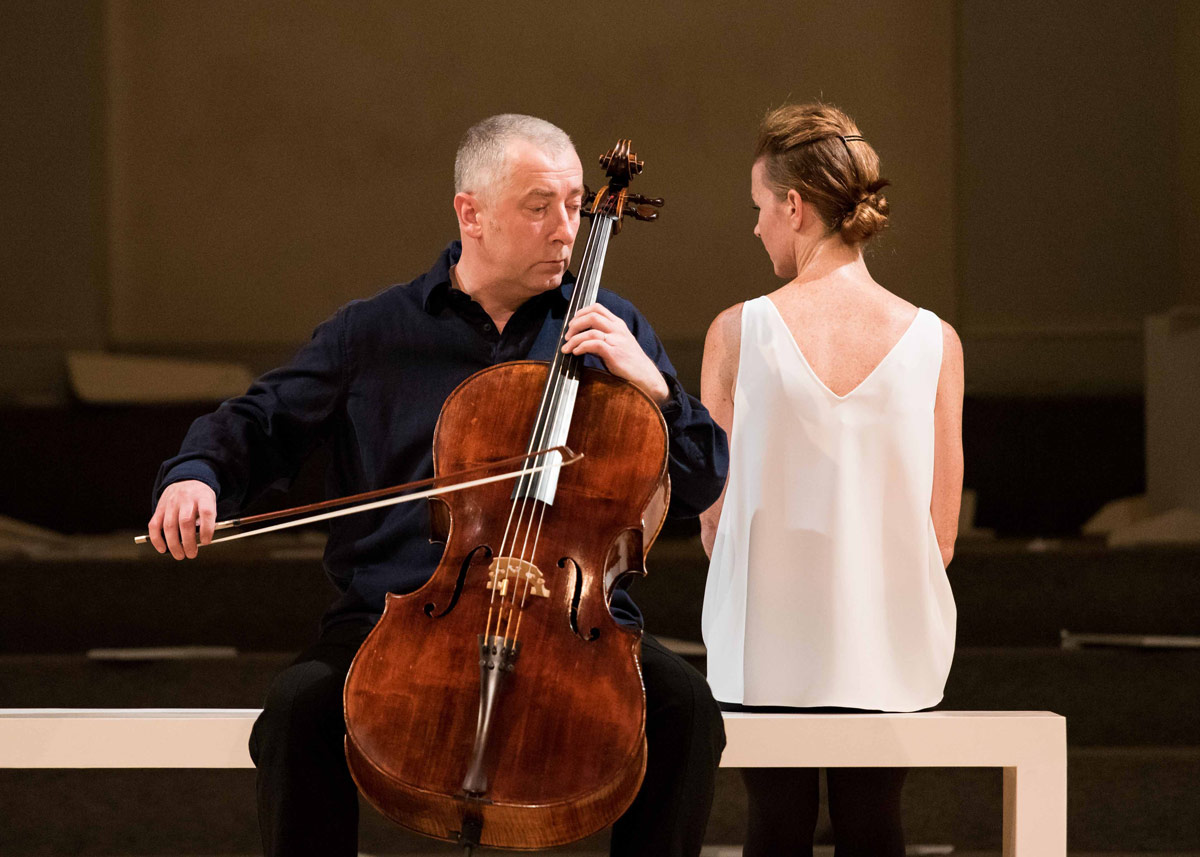
© Ian Douglas/courtesy Danspace Project. (Click image for larger version)
Jean Butler and Neil Martin
this is an Irish dance
New York, Danspace
17 November 2015
www.jeanbutler.com
www.danspaceproject.org
Shards of sheet rock littered the floor of St. Mark’s Church Tuesday night where Jean Butler, co-creator and original female lead of Riverdance, flitted among the proverbial wreckage – her footsteps like fairy whispers.
this is an Irish dance, her second work at Danspace, was created and performed with cellist Neil Martin, and has a post-apocalyptic feel about it. Whether it was supposed to be ice chunks or the ruins of an abandoned building, Butler and Martin moved around the stage and stared at each other enough to make you really believe they must be the last two people on earth. The silences were loud, and stomachs turned Tuesday night as several minutes of absolute quiet started the piece. Butler paces around the stage staring intently at Martin in a near-predatory fashion. Fear, distrust and skepticism are in the air. At times they stand uncomfortably close. A long eventually later, there are some dance moves.

© Ian Douglas/courtesy Danspace Project. (Click image for larger version)
Butler is making a very obvious departure from the stringent formalities of traditional Irish dance. She moves her pelvis (shock, horror!), she lunges, she uses her arms, she flexes her spine. The dancer is questioning forms, exploring new territory, unraveling, discovering. There is a somewhat forced countenance in this is… as if she is pondering what she can or cannot do, what will or won’t work, and what she has or hasn’t tapped yet. Irish dance is fascinating, not just for its rhythms and music, but because it has become such a contradiction: a social, folk art form that has become as formalized as competitive ballroom dancing. Official teachers must pass a grueling exam, there are committees, dress codes and high stakes international competitions. But even after a dancer has reached the top, like Butler, there are few places to perform compared to the realms of modern or contemporary dance or ballet. While there is inventive and interesting choreography within the realm and vocabulary of Irish dancing itself, it largely exists in a vacuum of its own, with few cross-disciplinary conversations. Butler is taking a stab at that.
The flitting flights Butler achieves in this is… can take your breath away, but they are few and far between. It is a sparse work, which might explain the gasp, the heart in your throat when you see three steps together, followed by a long sigh, because she is about to pace again. There is enough walking in this is…to seem indulgent, except when Butler creates rhythm with a heel-heavy stomp, a toe-heel step, or dazzles with a tightroping half-pointe. The staring between Butler and Martin is also a significant portion of the dramatic choreography, and despite what might have been an intended dramatic purpose, is so frequent as to become tedious, and falls flat. this is…is an essay that overstays its welcome, forced into full-length form, thus becoming over padded.

© Ian Douglas/courtesy Danspace Project. (Click image for larger version)
Regardless of Butler’s forays into alternative forms (the back flexing, non-Irish jumps, etc.), her upper body maintains the rigidity of Irish dance posture, so rather than a morphing of this mode with an “other,” this is… feels schizophrenic, a bit of this and that and back to some lost memory of an anchoring form. Contemporary movement and the Irish roots don’t quite meld, remaining separate in this chilly, chaste work.

















You must be logged in to post a comment.